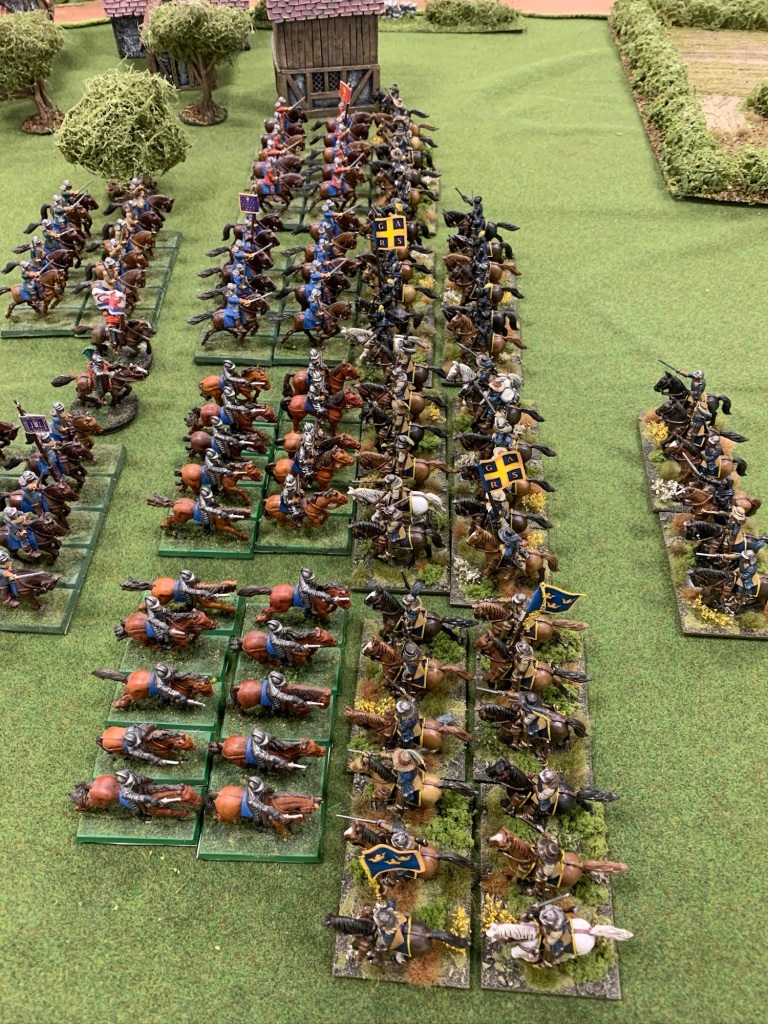Der Söldner is a scenario-based game. It is unsuitable for competitions. Pickup games of the my-box-against-yours are doable, but hard and somewhat awkward. The reason is the narrative. Creating the narrative of the battle at hand is the game mechanic, not the resultant of an I-Go-You-Go turn-based system.
Battles didn’t happen in splendid isolation. They still don’t, but are part of a larger narrative: the operational and strategic moves that went before it, the reason why the war started in the first place, the end-state the adversaries are aiming for and how this particular battle can bring that closer for the one and further away for the other. All that sets the scene for a scenario and determines victory and defeat. It is the framework for the challenges the game will provide. Without it the game is… a game. Nothing more.
This means that as game-master one must invest in preparing for a game. Creating a good scenario takes effort and time. This time I got it wrong.
What happened was a combination of X-mas vacation stuff and over-ambition. We had agreed before X-mas to do a game of Der Söldner last Friday. The aim was to do it in 28mm, set it in the 30YW, and with the miniatures at hand. Given the known sizes of the 28mm collections I first determined that a full blown battle like Breitenfeld or Lützen would be out of the question. So my first thoughts was to do something of a smaller combat set during the approach to such a large battle. A non-historical what if… scenario. Easy enough one would say. But then ambition kicked in. The next add-on was to go for a scenario at two levels: starting at an operational level and then have one or several smaller tactical level games. A kind off mini-campaign spread out over a number over BOD evenings. I ended up developing a “the road to Leipzig – 1632” scenario. Based on the events preceding the battle of Lützen, but with Wallenstein not going into winter quarters and sending Pappenheim to find and delay the Swedes. The problem I ran into was the required versus available miniatures and X-mas vacation stuff. I had made it too big and it was taking a lot more time than I had anticipated.

So on Friday morning I decided to make a U-turn. Forget about the operation and tactical level and create a straightforward avant-garde meets avant-garde scenario. Check what miniatures will indeed be available, as a few people had indicated not to be able to make it, and work from there. But I still wanted to make the game challenging. Add some “tough” question type things to it. I got it wrong again. You can find the scenario briefing via this link. Note that it is under review as I do plan to adjust it and have another go at it some time later.
What I got wrong, in hindsight, was the impact that time has in Der Söldner. Rounds represent variable amounts of time. Players do have some on control on this, but the dice have the final word. This is a deliberate design feature that allows the game to move on when needed. I have seen too many other games that just dragged on with units being pushed turn after turn until finally they got close to the enemy, or the evening ending with hardly any shots being fired. But it can go to quickly. And I could have known it. I should have known it. I should have checked the known table dimensions with the deployments and the distance between the armies at game start. I could have done it, but didn’t.
On top of that I had split both armies into an advanced on-table cavalry part and off-table infantry. The idea being that the cavalry would be upfront with the infantry on the road behind them. When the enemy is sighted the cavalry would deploy while the infantry is still advancing an arrives later. I gave each player a secret note at game start indicating how much time their infantry still needed to get to the battlefield. I did some math on that using Google Maps, taking into account the length of typical march columns, etc, and from there estimated how much time the frontmost units would need to get to where I had put the table edge. Easy… but wrong.
I forgot about the time the cavalry would be needing to deploy after having made the first sighting of the enemy. As such perhaps not really a problem because the only result is that the infantry needs a little more time to get to the battle. But because I also made a miss on the distance between the two cavalry forces at game start this difference in time made all the difference.
And that brings me by another mistake I made.

When one designs a scenario one quickly starts thinking of all possible ways in which it may play out. It happened to me in this case too. Grand schemes crossed my minds. Eloquent manoeuvres that considered the yet to arrive infantry within the context of the victory conditions as I had set them. A small combat turned in a truly majestic fight. Worthy of many a PhD thesis in centuries to come. But we all know Mike Tyson: everybody has a plan until they get hit in the face.
So my question to you: what happens when one deploys two forces of heavy cavalry facing each other? Add that the one is lead by Gottfried Heinrich Graf zu Pappenheim, for whom I had created the keyword RASH, and the other by Gustavus Adolphus.

The game was quick. Not unsatisfactory, but admittedly the challenge for the Swedish player was quickly gone. The reason I still consider it satisfactory is how the cavalry fight happened, evolved, and reached its conclusion. Also in hindsight I feel it happened as it would/could have in reality. Also the time it took. As I mentioned, in Der Söldner creating the narrative is the mechanism. And the narrative, and hence the game, in this case did read as one could have read it in a history book. If indeed it would have happened back in 1632. But this was a what if… scenario.
We decided to call it a day before the first infantry units would arrive. We discussed how the engagement might develop, but the momentum of the game was past its prime.
And then an interesting discussion popped up: how did commanded shot really work in supporting cavalry?
The Swedish had been allotted a unit of commanded shot. In the game they were ridden down by pursuing Imperialist cuirassiers. They were initially deployed a bit on the side and during the game argued to move towards Gustavus in order to protect him, but it turned out that this move put them right into the path of fleeing Swedish cavalry and their pursuers.

We decided to redeploy the units, but now with the commanded shot elements deployed between the cavalry units. We then discussed various options we had heard, read, or learned about, and how these might work out in Der Söldner. In the end we felt that the Swedish Salvo option might be the most feasible. In this case the Imperialist cavalry would be advancing while the Swedes hold their ground until the Imperialists are close enough for a salvo at effective range. The aim would be to cause disorder in the ranks of the imperialists, perhaps even a brief halt of the advance. This would be the moment for the Swedish cavalry to advance and engage the now disturbed Imperialists at a moment when some of the impetus of their advance would be gone. The safety of the commanded shot in this setup lies in the success of the Swedish cavalry. As I write this, it does read a bit like how the British infantry during the Napoleonic wars was able to defeat many French columns: hold fire until the French were really close, let loose a devastating volley, followed by a quick and brief countercharge that settles the matter.
What I found most interesting of this discussion on commanded shot is that all options we addressed would work out fine in Der Söldner, but would be very hard in any turn-based ruleset. And most of all that this discussion was triggered!

